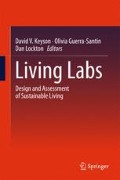Abstract
Food consumption represents a significant environmental impact, and in terms of climate impact, food consumption ranks among the top three contributing sectors. By changing dietary choices and reducing food waste, significant reductions in food-derived GHG emissions can be achieved. However, food consumption behavior depends on several interrelated factors, some of which have proved difficult to influence. Further research and new approaches in data collection and intervention design are needed to identify effective strategies. Here, a web-based tool for collecting highly disaggregated data on household food consumption and food waste behavior, called Food Watch, is presented. I present the results of an early version field trial, with detailed analysis of food waste categories and a discussion about intervention and feedback design. A roadmap for future research and development of the Food Watch application is also presented.
Access this chapter
Tax calculation will be finalised at checkout
Purchases are for personal use only
References
Ajzen, I. (1991). The theory of planned behavior. Organizational Behavior and Human Decision Processes, 50(2), 179–211. doi:10.1016/0749-5978(91)90020-T.
Berners-Lee, M., Hoolohan, C., Cammack, H., & Hewitt, C. N. (2012). The relative greenhouse gas impacts of realistic dietary choices. Energy Policy, 43, 184–190. doi:10.1016/j.enpol.2011.12.054.
Carlsson-Kanyama, A. (1998). Climate change and dietary choices—How can emissions of greenhouse gases from food consumption be reduced? Food Policy, 23(3–4), 277–293, doi:http://dx.doi.org/10.1016/S0306-9192(98)00037-2.
Carlsson-Kanyama, A., & González, A. D. (2009). Potential contributions of food consumption patterns to climate change. The American Journal of Clinical Nutrition, 89(5), 1704S–1709S. doi:10.3945/ajcn.2009.26736AA.
Carlsson, A., Palm, V., & Wadeskog, A. (2006). Energy use and CO2-emissions for consumed products and services. IPP-indicators for private and public consumption based on environmental accounts SCB.
Finn, S. M. (2014). Valuing our food: Minimizing waste and optimizing resources. Zygon, 49(4), 992–1008. doi:10.1111/zygo.12131.
Graham-Rowe, E., Jessop, D. C., & Sparks, P. (2014). Identifying motivations and barriers to minimising household food waste. Resources, Conservation and Recycling, 84(0), 15–23, doi:http://dx.doi.org/10.1016/j.resconrec.2013.12.005.
Harder, R., Kalmykova, Y., Morrison, G. M., Feng, F., Mangold, M., & Dahlén, L. (2014). Quantification of goods purchases and waste generation at the level of individual households. Journal of Industrial Ecology, 18(2), 227–241. doi:10.1111/jiec.12111.
Kahiluoto, H., Kuisma, M., Kuokkanen, A., Mikkilä, M., & Linnanen, L. (2014). Taking planetary nutrient boundaries seriously: Can we feed the people? Global Food Security, 3(1), 16–21. doi:10.1016/j.gfs.2013.11.002.
Quested, T. E., Marsh, E., Stunell, D., & Parry, A. D. (2013). Spaghetti soup: The complex world of food waste behaviours. Resources, Conservation and Recycling, 79, 43–51, doi:http://dx.doi.org/10.1016/j.resconrec.2013.04.011.
Reynolds, C., Buckley, J., Weinstein, P., & Boland, J. (2014). Are the dietary guidelines for meat, fat, fruit and vegetable consumption appropriate for environmental sustainability? A Review of the Literature. Nutrients, 6(6), 2251–2265.
Scarborough, P., Appleby, P., Mizdrak, A., Briggs, A. M., Travis, R., & Bradbury, K., et al. (2014). Dietary greenhouse gas emissions of meat-eaters, fish-eaters, vegetarians and vegans in the UK. Climatic Change, 125(2), 179–192. doi:10.1007/s10584-014-1169-1.
Triandis, H. C. (1977). Interpersonal behavior. Brooks/Cole Pub. Co.
Author information
Authors and Affiliations
Corresponding author
Editor information
Editors and Affiliations
Rights and permissions
Copyright information
© 2017 Springer International Publishing Switzerland
About this chapter
Cite this chapter
Knutsson, J. (2017). FoodWatch and Food Resource Flows. In: Keyson, D., Guerra-Santin, O., Lockton, D. (eds) Living Labs. Springer, Cham. https://doi.org/10.1007/978-3-319-33527-8_21
Download citation
DOI: https://doi.org/10.1007/978-3-319-33527-8_21
Published:
Publisher Name: Springer, Cham
Print ISBN: 978-3-319-33526-1
Online ISBN: 978-3-319-33527-8
eBook Packages: EngineeringEngineering (R0)

